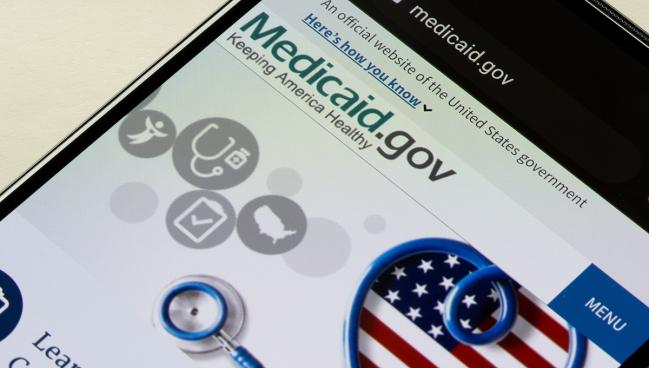Medicaid Patients With Type 2 Diabetes Face Hurdles Getting Cardioprotective Meds
SGLT2 inhibitors and GLP-1 agonists are class 1 medications, but many Medicaid patients have challenges with access.

A large percentage of patients with type 2 diabetes enrolled in Medicaid have restricted access to sodium-glucose cotransporter 2 (SGLT2) inhibitors and glucagon-like peptide-1 (GLP-1) receptor agonists, two drug classes with proven cardioprotection, according to an analysis published this week in the Annals of Internal Medicine.
It’s estimated that among roughly 6.8 million patients with diabetes enrolled in the Medicaid program, 25% have restricted access to an SGLT2 inhibitor and 40% have limited availability to a GLP-1 receptor agonist, report investigators.
“These are the first two classes of medications that I would say convincingly, and in replicated randomized, controlled trials, have demonstrated reductions in cardiovascular events and mortality [in patients with diabetes],” lead investigator Anil Makam, MD (University of California, San Fracisco), told TCTMD. “In some ways, we’re trying to solve the evidence-translation gap.”
Once a drug or therapy has been demonstrated safe and effective in clinical trials, it’s no secret that it takes a long time to be adopted into mainstream practice, he said. However, “you can’t prescribe it if it’s not available, or at least if it’s available, with a lot of hoops and hurdles as we’re describing here,” said Makam.
A decade has passed since investigators showed that the SGLT2 inhibitor empagliflozin (Jardiance; Boehringer Ingelheim/Eli Lilly) significantly reduced the risk of major cardiovascular events, as well as mortality, in the EMPA-REG OUTCOME trial. The GLP-1 receptor agonists were also originally approved for glycemic control in patients with diabetes but have since been shown to reduce cardiovascular and renal events, as well as mortality, in those with—or at high risk for—concomitant atherosclerotic cardiovascular disease (ASCVD).
Both SGLT2 inhibitors and GLP-1 receptor agonists are recommended for patients with type 2 diabetes in multiple guidelines, including those from the American Diabetes Association and the American College of Cardiology. In the European Society of Cardiology guidelines, both drug classes have class 1 indications for patients with type 2 diabetes and ASCVD, chronic kidney disease, heart failure, or a high risk of ASCVD. Data has shown that SGLT2 inhibitors remain underused in eligible patients, as are GLP-1 receptors, with their high costs often to blame.
“These drugs are now considered first-line therapy for many individuals with diabetes,” said Makam. “It’s not a minority of people.”
Access Varies Geographically
The new study is a cross-sectional analysis of Medicaid formularies for fee-for-service plans in all 50 US states, as well as Washington, DC, and managed care organization plans with coverage across 39 states (11 states didn’t participate in these programs). The goal was to assess unrestricted formulary availability to at least one SGLT2 inhibitor or GLP-1 receptor agonist, with unrestricted defined as not requiring prior authorization or “step therapy” before the prescription was granted. Exenatide was excluded because it has not been shown to have the same cardiovascular, renal, or mortality benefits as other GLP-1 receptor agonists.
With Medicaid, states are guaranteed matching federal funds for qualified services to eligible enrollees and roughly three-quarters of all Medicaid enrollees receive care through the managed care organizations.
While Medicaid is federally mandated to cover diabetes medications approved by the US Food and Drug Administration, “that doesn’t mean that they can’t be put behind onerous, burdensome formulary restrictions,” said Makam. “If they put it on their preferred drug list, they can add prior authorization or step-therapy restrictions. There’s no requirement that those restrictions have to follow any kind of guidelines or evidence.”
You can’t prescribe it if it’s not available, or at least if it’s available, with a lot of hoops and hurdles. Anil Makam
Among fee-for-service plans, 40 states had an SGLT2 inhibitor, 30 had a GLP-1 receptor agonist, and 29 had both drugs available on their preferred drug list. Tirzepatide (Zepbound; Eli Lilly), a potent dual glucose-dependent insulinotropic polypeptide (GIP) and GLP-1 receptor agonist, was available in only a single state. Prior authorization was the most common restriction for both drug classes. In contrast, 42 states had a dipeptidyl peptidase-4 (DPP-4) inhibitor, which is considered a second-line agent, available.
Of the 273 Medicaid managed care organizations, 66.7% had an SGLT2 inhibitor available, 48% had a GLP-1 receptor agonist available, and 47.3% had both drugs. The availability of both drug classes was variable across states. Tirzepatide was restricted in all managed care organizations, whereas a DPP-4 inhibitor was available in nearly 75% of plans. Among all 273 plans, 10% required clinicians to try an alternative medication first before approving an SGLT2 inhibitor or GLP-1 receptor agonist (step-up requirement), while prior authorization was needed in roughly 60% of plans.
“Depending on what state and what plan [you’re in]—you can be in the same state and under a different managed care organization—you can have variable access to these medications,” said Makam. “We think it’s a big lever to potentially investigate in making these medications more freely available to increase adoption and adherence and ultimately decrease cardiovascular events and extend lives.”
Controlling Costs
Placing a step-up restriction on these medications makes little sense as they are prescribed to reduce the risk of ASCVD events, not simply to improve glycemic control, said Makam. Also, the major cardiovascular outcome trials with SGLT2 inhibitors and GLP-1 receptor agonists in patients with diabetes showed the benefits of treatment occur early.
“These are short time horizons to benefit,” he said. “Unlike intensive glycemic control, which takes 10 to 20 years to realize any meaningful benefit, this is in the order of months, and absolute benefits will accrue over time.”
The DPP-4 inhibitors are also expensive medications and yet these drugs are more widely available under Medicaid fee-for-service and managed care organization plans. While these agents are excellent for glycemic control, there are many other inexpensive options instead of DPP-4 inhibitors that could be used.
“Given the unique evidence—the benefits of reducing cardiovascular disease—and that constraining pharmaceutical cost is a high priority for plans, switching restrictive coverage to DPP-4 medications and making the SGLT2 and GLP-1 medications more available might offset some of those added costs,” said Makam.
While the drugs aren’t cost-effective to commercial payers at their current prices, there are sizeable Medicaid drug rebates, he said. This brings their price down considerably and pushes the drug closer to currently acceptable cost-effectiveness thresholds, said Makam.
Michael O’Riordan is the Managing Editor for TCTMD. He completed his undergraduate degrees at Queen’s University in Kingston, ON, and…
Read Full BioSources
Makam AN, Bailey L, Anderson N, et al. Availability of cardioprotective medications for type 2 diabetes in Medicaid program. Ann Intern Med. 2025;Epub ahead of print.
Disclosures
- Makam reports no conflicts of interest.





Comments